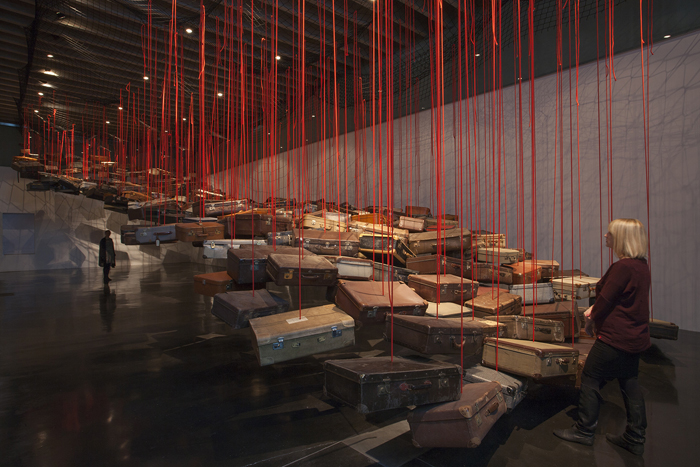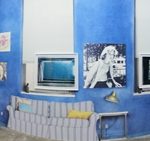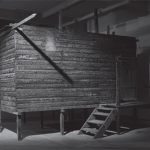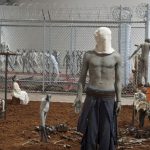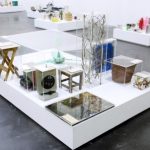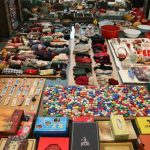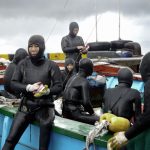In South Korea the word “exhibition” seems to be translated as “biennale”. At the moment the Koreans are hosting at least four biennales, if one includes the Daegu Photography Biennale (until 19 October). Last week I managed to catch the other three, two of which have begun in an atmosphere of high controversy.
The most prestigious of the Korean events, and one of the leading international exhibitions on the contemporary art calendar is the Gwangju Biennale, now in its 10th incarnation. The show has been put together by British curator, Jessica Morgan, under the title, Burning Down the House. You will probably recognise this as a Talking Heads song from the 1980s, with a funk beat and incomprehensible lyrics.
Morgan has chosen to interpret her theme in a two-fold manner. The inspiration for the song came from Heads’ drummer, Chris Frantz, who attended a Funkadelic concert where the crowd started to chant: “Burn Down the House!” According to the curator: “The hedonism of the P-funk crowd on the dance floor was then turned into an anthem of bourgeois anxieties by the New York band. This dual meaning of pleasure and engagement captures the defining spirit of the 10th Gwangju Biennale.”
In truth this theme captures the defining spirit of almost anything. The event that will forever define the Gwangju Biennale was a notorious massacre of 1980 when government troops fired upon a peaceful student demonstration. The Biennale was founded in 1995 “in memory of the spirit of civil uprising”, which means the show always has a political dimension.
Morgan has addressed this need by invoking “the process of conflagration and transformation, a cycle of obliteration and renewal.” This allows for the inclusion of many politically engaged works, some pieces confronting a particular issue head-on while others take a more oblique approach. The strangest aspect of the selection, regardless of politics, is that so many pieces simply refer to “burning”, or to “house”.
For instance, the largest installation in the show is Urs Fischer’s room-by-room simulation of his former New York apartment in which walls and contents are photo-reproduced on wallpaper. As there doesn’t seem to be anything especially political about this apartment – unless Fischer is critiquing his own bourgeois tastes – we can only assume it stands for the “house” section of the show.
Conversely, a panel with abstract squiggles in pokerwork, by Anwar Shemza, or a smoke-tinged piece of paper held near a fire by Yves Klein, are representative of “burning”. Eduardo Basualdo’s The Island probably deserves a special mention, being a scaled-down house reconstructed from the burnt remnants of a building in Buenos Aires. Neither should we overlook Sterling Ruby, who has contributed four large cast-iron stoves, in reference to home and hearth. It’s like a game: “Get both ‘house’ and ‘burning’ into a single artwork.”
Such extreme literalness feels a bit trivial alongside the politically oriented works, despite the slightly sinister overtones of Basualdo or Ruby’s contributions.
The only Australian artist included is Ken Unsworth, with a series of small black-and-white performance photos from 1975. It appears that Morgan hardly gave Australia a second thought, even though we have more bushfires and TV home improvement programs than any other nation.
By all accounts the opening was spectacular, not simply for the fireworks and circus acts, but for a censorship scandal that led to the resignation of the President of the Biennale Foundation. The problem arose with a satellite exhibition at the Gwangju Museum of Art called Sweet Dew – After 1980, which celebrated 20 years of the Biennale. A large painting by Hong Sung-dam that depicted Korean President, Park Geun-hye, confronting the angry parents of children who died in April’s ferry disaster, was pulled from the show by museum officials.

This was ironic for a Biennale founded in honour of civil dissent. The other irony is that Sweet Dew (a Buddhist term) is arguably a better, more coherent show than the official Biennale. It features a remarkable series of paintings by ‘comfort women’, kidnapped and abused by Japanese troops during the occupation; a sub-section devoted to prints by Kathe Köllwitz, Ben Shahn and Chinese revolutionary artists; and engaging pieces by Lee Lee-nam (whose solo show continues at the Korean Cultural Office until 24 October), Zhang Huan, Park Daesung, and others.
To be fair to Morgan, who allegedly washed her hands of the censorship controversy, she did manage to assemble some strong figurative work, including paintings by Liu Xiaodong and Tetsuya Ishida, and a large-scale installation by Jane Alexander. A gigantic, space-consuming installation of obsolescent junk – Geng Jianyi’s Useless (2004) – would have been more striking if Song Dong’s globe-trotting installation, Waste Not (2005), hadn’t already introduced us to so many varieties of Chinese refuse. It’s merely incidental that Geng’s work came first.
If Burning Down the House was a patchy affair it seemed like a masterpiece alongside this year’s Busan Biennale. This time the controversy began with the choice of director. The job had been awarded to local curator, Kim Seong-youn, by a clear majority vote, when the powerful Chairman of the operating committee, Oh Kwang-su, demanded that Kim work in collaboration with runner-up, Frenchman Olivier Kaeppelin, director of the Fondation Maeght, in Saint-Paul-de-Vence.
Kim refused and promptly resigned, leaving Kaeppelin as sole director. The resulting fracas forced Oh’s resignation, but the Biennale went ahead. The result is an exhibition that inculcates the worst form of French cultural chauvinism. Roughly a third of the artists in the show are from France, or French-speaking territories; while the theme: Inhabiting the World is vague even by biennale standards. Life on Mars would’ve been more enticing.
Kaepplin’s catalogue introduction is textbook art waffle, requisitioning a large number of words in order to say precisely nothing. The problems were compounded by an English-language translation that serves up sentences like this: “During major crisis the man had always have to deal with a fear of a zombie…” (sic)
There are too many mediocre paintings in this selection, most of them drawn from the private collection of Dr. Bernard Massini, a French neurosurgeon whose collection was hosted at the Fondation Meaght last year. One can hardly avoid the suspicion that putting Dr. Massini’s works into an international show was one of the motivating factors behind the selection. It’s an especially tempting idea considering the city of Busan paid for everything.
This was too cosy for comfort, and a conspicuously lazy way of assembling an exhibition. Some of the French artists included in this biennale were shown in Sydney Biennales 20-30 years ago. There are tokenistic inclusions of small pieces by wellknown figures such as Anish Kapoor and Richard Deacon. The most substantial contribution comes from Chiharu Shiota, with an elaborate installation of hundreds of suitcases suspended from the ceiling by red thread.
Incidentally, the only ‘Australian’ inclusion, and one of the better artists, was abstract painter Lawrence Carroll (b. 1954), who has lived in the United States since 1958.
On the opening day the art was upstaged by the opening ceremonies organised by the Busan authorities, the highlight being a Swiss musical celebration staged by the local Rotary Club, complete with yodelling, Alpine horns, cow bells, lederhosen and dirndls. This was followed by a pair of glamour girls in short black dresses doing a routine with electric violins that would’ve made Tina Turner blush.
These performances were, without doubt, the most avant-garde aspect of the display.
The big surprise was the Biennale I never actually knew about until I arrived in Seoul – the SeMA Biennale at Mediacity Seoul, which went by the wonderful title, Ghosts, Spies and Grandmothers. The artistic director was filmmaker, Park Chan-kyong, who put together a show with all the humour, quirkiness and imagination that had been missing from Gwangju and Busan. It was extraordinary how many works Park managed to find that fitted his eccentric theme, and how expansive that theme became. The exhibition began with a long shamanic incantation and had enough twists and turns to keep viewers guessing to the end. I’m still thinking about the pearl-diving grannies of Jeju Island; the antics of the Japanese Zero Dimension group; and the North Korean statues scattered all over Africa. Note for the future: perhaps more biennales should be selected by film directors.
Gwangju Biennale: Burning Down the House
Gwangju Biennale Hall, until 9 November.
Busan Biennale: Inhabiting the World
Busan Museum of Art, until 22 November.
SeMA Biennale: Ghosts, Spies and Grandmothers
Mediacity, Seoul, until 23 November.
Published in the Sydney Morning Herald, Saturday 4th October, 2014

